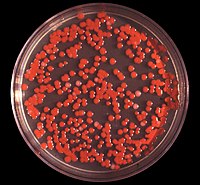
Photo from wikipedia
Serratia marcescens is a ubiquitous bacterium from order Enterobacterales displaying a high genetic plasticity that allows it to adapt and persist in multiple niches including soil, water, plants, and nosocomial… Click to show full abstract
Serratia marcescens is a ubiquitous bacterium from order Enterobacterales displaying a high genetic plasticity that allows it to adapt and persist in multiple niches including soil, water, plants, and nosocomial environments. Recently, S. marcescens has gained attention as an emerging pathogen worldwide, provoking infections and outbreaks in debilitated individuals, particularly newborns and patients in intensive care units. S. marcescens isolates recovered from clinical settings are frequently described as multidrug resistant. High levels of antibiotic resistance across Serratia species are a consequence of the combined activity of intrinsic, acquired, and adaptive resistance elements. In this review, we will discuss recent advances in the understanding of mechanisms guiding resistance in this opportunistic pathogen.
Journal Title: PeerJ
Year Published: 2023
Link to full text (if available)
Share on Social Media: Sign Up to like & get
recommendations!